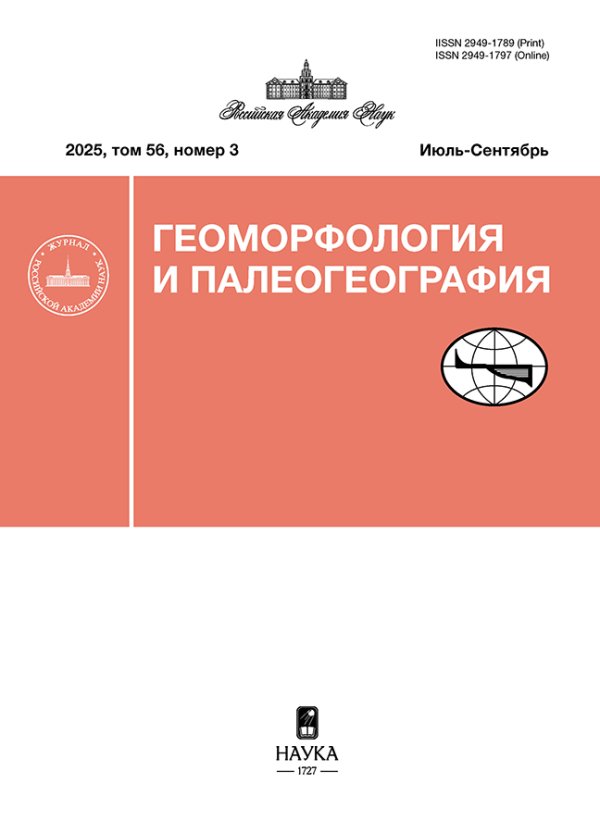Том 55, № 1 (2024)
- Год: 2024
- Выпуск опубликован: 15.03.2024
- Статей: 9
- URL: https://journals.rcsi.science/2949-1789/issue/view/16328
Весь выпуск
ЭКЗОГЕННЫЕ ПРОЦЕССЫ РЕЛЬЕФООБРАЗОВАНИЯ
Вертикальные деформации русел рек России под влиянием русловых карьеров
Аннотация
На основе сопоставления нивелировок продольного профиля ряда равнинных рек России выявлены интенсивность распространения полувековых деформаций продольного профиля, обусловленных нарушением стока наносов и морфологии русла. Эта проблема остается актуальной и в теоретическом, и практическом аспектах, особенно для рек, на которых серии русловых карьеров занимают километры и десятки километров, и их разработка продолжается десятки лет. Изъятие из транспорта наносов большого количества аллювиального материала и изменение морфометрических характеристик речного русла дали толчок процессу выравнивания транспортирующей способности потока по длине реки путем врезания. Результатом является понижение дна и водной поверхности. Интенсивность врезания достигала 3–8 см, а его распространение по реке 400–700 м/год. Ярко выражена регрессивная эрозия, трансгрессивная же менее выражена, так как частично заменена механическим изъятием аллювиального материала. В ходе деформаций форма продольного профиля сменилась с выпуклой или прямой на вогнутую, и признаков восстановления за истекшие десятилетия не наблюдается несмотря на то, что в последние 30 лет на исследованных реках добыча производится в умеренных масштабах или прекращена.
 5-12
5-12


Особенности формирования и деформации русла большой реки во внутригорной котловине (на примере р. Яны в пределах Куларского горного массива)
Аннотация
Врезанные галечно-валунные русла крупных рек в горах (в том числе — Яны на ее горном участке) достаточно хорошо изучены с точки зрения морфологии и истории формирования. Однако местные условия, возникающие в расширениях долины в пределах внутригорных котловин, приводят к проявлению специфических особенностей развития русла и его морфологии — в данном случае, формированию пальцеобразной излучины. В статье дан анализ истории развития и многолетних (за время формирования поймы) деформаций русла р. Яны на участке “Пороги”, расположенном во внутригорной котловине Куларского хребта, а также описано негативное их влияние на состояние водного пути. На примере этого участка рассмотрены закономерности развития русла крупной реки в условиях действия комплекса факторов — геологического строения котловины (обусловившего активное врезание русла), стока воды и состава русловых наносов. Приведены характеристики смещения и искривления излучины в условиях выхода в русле скальных пород, вскрывающихся в процессе горизонтальных переформирований, и подпора потока от нижерасположенного сужения долины. Рассчитаны интервалы расходов воды, при которых возможно смещение перекатов, и их продолжительность. Дан прогноз дальнейшего развития русла и обоснованы рекомендации по его регулированию в целях обеспечения устойчивого судоходства.
 13-25
13-25


Многолетняя динамика скоростей горизонтальных русловых размывов на реках Удмуртии
Аннотация
Представлены результаты исследования смещения русел за 2000–2022 гг. на 55 ключевых участках, расположенных на реках разного порядка, протекающих в условиях различных ландшафтов Удмуртии. Скорости размыва определялись с помощью реперов и тахеометрической съемки. Для анализа полученных результатов реки были разделены на 4 группы по величине их порядков (по методике А. Шайдеггера). Максимальные размывы характерны для рек с порядком выше 14 (до 15 м/год), для средних рек с порядком 9–14 эти величины составляют 6–8 м/год. Для малых рек с порядком 6–9 максимальные размывы достигали 5.5 м/год, а для очень малых рек (порядок 6 и менее), соответственно до 4.2 м/год в естественных условиях и до 8.1 м/год при техногенном вмешательстве. Получены статистические показатели среднегодовых и максимальных размывов на реперных участках за рассматриваемый период. Корреляционный анализ показал наличие высокой достоверной связи между скоростью размыва и порядком реки и, соответственно, среднегодовыми и максимальными расходами. Связь же величин размыва с годовой суммой осадков обнаружена только для трех малых рек в бассейне р. Кильмезь, сложенной с поверхности песчаными отложениями. Проведен анализ размывов за 23-летний временной интервал с определением уравнения тренда по выделенным группам рек.
 26-39
26-39


Оценка стока наносов с территории Москвы
Аннотация
В результате хозяйственного освоения на территории Москвы (в пределах кольцевой автодороги) за XVIII–XX вв. было засыпано чуть больше половины долин малых рек и десятки оврагов. Параллельно была сооружена сеть ливнестоков (подземных труб) со средней густотой 6.9 км/км2. Доля водонепроницаемых поверхностей (крыши зданий, тротуары, автодороги и т. д.) возросла до 50%. Поверхностный сток с городских территорий вместе с грунтом, взвешенными и растворенными веществами стал реализовываться через ливнесточную сеть в русла сохранившихся рек, в пруды. В настоящей работе на основе полевых материалов авторов, полученных на модельном участке (бассейне заключенного в коллектор Калитниковского ручья) и статистических данных коммунальных организаций проведена оценка стока наносов и растворенных веществ с территории Москвы (внутри МКАД) через сеть “подземных рек” и ливнестоков. Установлено, что с учетом площади (880 км2), модуль твердого стока здесь составляет в среднем порядка 160–250 м3/км2 в год (или 2.6–4 т/га в год) при доле водонепроницамых поверхностей 50%. Показано, что даже в пределах плоских поверхностей (например, надпойменных террас) с амплитудами высот менее 6–7 м смывается около 100 м3/км2 грунта в год. Основные причины наблюдаемого явления — низкая культура благоустройства (некачественно закрепленные грунты, недостаточная очистка ливнесточных вод), массовое строительство и интенсификация эолового транзита в застроенных кварталах. Поступающие из ливнестоков разнодисперсные частицы грунта и другие взвешенные вещества превышают транспортирующую способность сохранившихся рек, что приводит к аккумуляции наносов в руслах. Потенциал Москвы-реки по удалению возросшего стока наносов и загрязнителей к настоящему времени полностью исчерпан.
 40-51
40-51


Ледниковый рельеф центральной части Кольского региона
Аннотация
В связи с улучшением качества доступных цифровых моделей рельефа и космических изображений поверхности Земли, в последнее время складывается тенденция к интерпретации этой информации без достаточного подтверждения геологическими методами исследований. При этом именно данные о геологическом строении аккумулятивных ледниковых форм рельефа имеют решающее значение для интерпретации их генезиса и для реконструкции природной среды области последнего оледенения. В статье приведена классификация и характеристика геологического строения ледникового рельефа одного из ключевых участков Кольского региона. Она выполнена на основе морфометрических методов анализа рельефа, геолого-структурных методов, петрографического анализа крупнообломочного материала ледниковых отложений и исследования донных осадков озер. В районе работ были установлены две полосы ледникового аккумулятивного рельефа.
К первой полосе относится параллельно-грядовый рельеф на южном склоне Ловозерских Тундр. Он представляет собой образования боковой насыпной морены, которая формировалась у края ледника, двигавшегося с запада на восток вдоль склона. Также в состав этой полосы включен холмисто-грядовый рельеф вдоль склонов Ловозерских, Панских и Фёдоровой Тундр, который построен напорными конечно-моренными образованиями. Их слагают дислоцированные лимно- и флювиогляциальные отложения, а также насыпные и абляционные морены.
Вторая полоса образована тремя субпараллельными цепочками грядово-холмистого рельефа. В их строении участвуют складчатые и чешуйчато-надвиговые гляциодислокации. На дистальном склоне внешней цепочки развиты флювиогляциальные отложения.
Обе полосы ледникового рельефа сопоставляются с краевыми образованиями двух фаз сокращения последнего ледникового покрова. Анализ моделей дегляциации последнего ледникового покрова в Кольском и смежных регионах и информация о положении известных краевых образований позволили соотнести эти фазы с заключительными эпизодами лужской (карельской) и невской (сямозерской) фаз. Полученная информация позволяет более детально определить этапы развития последнего ледникового покрова и ход дегляциации Кольского региона в позднеледниковье.
 70-92
70-92


Динамика клифов западного Крыма
Аннотация
Рассмотрена многолетняя динамика клифов Западного Крыма. Анализируются спутниковые снимки открытого доступа и продолжительные (более 40 лет) данные измерений на створах. Приводятся данные о геоморфологии отдельных участков побережья. Показано, что на бóльшей его части основным механизмом, вызывающим отступание клифов, являются обвалы. Оползни характерны для побережья к югу от р. Кача, их подвижки сравнительно редки. Усиление обвальных процессов наблюдается в зимне-весенний период, когда значительно увеличивается влажность глинистых пород клифа и абразия. Обвалы могут также провоцироваться кратковременными сильными осадками, которые обычно наблюдаются в летний период. Однозначная связь между годовыми суммами осадков, штормовой деятельностью и активностью оползней синхронно или со сдвигом во времени не выражена. Какой-либо периодичности в динамике оползней не выявлено. Установлено, что характерные среднемноголетние скорости отступания бровки клифа для отдельных участков составляют от 0.1 до 1.2 м/год. В северной части побережья скорости максимальные, по мере продвижения к южной части региона они уменьшаются. Полученные среднемноголетние скорости отступания бровки клифа существенно меньше ранее приводимых в литературе. Отмечено сокращение поступления пляжеобразующего материала в береговую зону из-за уменьшения протяженности клифов. Из первоначально существовавших в рассматриваемом районе 50 км берегов с клифами из-за их закрытия различными сооружениями и террасирования к настоящему времени осталось 39 км. Обсуждается антропогенная деятельность, которая приводит к образованию техногенных оползней и увеличению активности природных оползней. Показано, что строительство поперечных пляжеудерживающих сооружений приводит к блокированию вдольберегового потока наносов и вызывает увеличение скорости отступания клифов за пределами закрепленного участка.
 52-69
52-69


ИСТОРИЯ РАЗВИТИЯ РЕЛЬЕФА
Морфодинамика и морфотектоника района устья р. Варзуги (Терский берег Белого моря) в позднеледниковье и голоцене
Аннотация
Поздне- и послеледниковая история развития береговой зоны Белого моря в районе устья р. Варзуги рассматривается как результат взаимодействия эндогенных и экзогенных факторов морфолитогенеза. На основе новых геоморфологических исследований, изучения голоценовых отложений методами литостратиграфического, диатомового и радиоуглеродного анализов, а также анализа литературных источников, получены сведения о развитии рельефа района за ~13 тыс. кал. л. н. Определены черты региональной иерархической морфоструктуры и локальной постледниковой тектоники территории — пространственные соотношения блоков и скорости вертикальных движений. Впервые выделена наложенная линейная Нижневарзугская депрессия, которая определяла конфигурацию эстуария р. Варзуги в поздне- и послеледниковое время. Установлено влияние пространственного соотношения блоков и дифференцированного послеледникового поднятия на прибрежный морфолитогенез. Реконструированы ход изменения относительного уровня моря (ОУМ), условия развития и морфодинамика берегов открытого побережья и эстуария р. Варзуги, получены новые данные о ритмах процессов прибрежного морфолитогенеза (береговых, устьевых и эоловых). Выделены три этапа развития береговой зоны, соответствующих региональным ритмам изменений ОУМ и климата: (I) позднеледниковой трансгрессии и раннеголоценовой регрессии (~12–9.8 тыс. кал. л. н.), (II) среднеголоценовой трансгрессии Тапес (~7.8–4.9 тыс. кал. л. н.), (III) позднеголоценовой регрессии (после ~4.9 тыс. кал. л. н.). Верхняя морская граница позднеледниковой трансгрессии прослежена западнее Нижневарузгской депрессии на высотах ~54–55 м, к востоку от нее — ~39–40 м, а в депрессии — 22–25 м над у. м. Берега более низких морфоструктурных блоков до ~10.2–9.8 тыс. кал. л. н. были, вероятно, блокированы мертвым льдом. Во время трансгрессии Тапес ОУМ достиг максимума (~7.8–7.6 тыс. кал. л. н.; ~20 м), а к ~ 4.9 тыс. кал. л. н. понизился до ~15 м над у. м. Направления потоков наносов, ветров и подхода волн стали близки современным, однако основными источниками наносов оставались размыв водно-ледниковых отложений и поступление песков с морского дна. В интервале ~4.9–1.7 тыс. кал. л. н. ОУМ понизился до ~5 м. Твердый сток р. Варзуги стал основным источником питания берегов.
 93-129
93-129


Этапы развития рельефа в районе палеолитической стоянки Ушбулак (Восточный Казахстан)
Аннотация
Исследование выполнено при поддержке РНФ № 21-78-10146 “Верхнепалеолитическая мозаика — культурно-технологическая изменчивость каменных индустрий предгорных зон севера Центральной Азии во второй половине позднего плейстоцена” (полевые работы и абсолютное датирование), геоморфологические исследования выполнены в рамках госзадания географического факультета МГУ им. М.В. Ломоносова (№ 121040100323-5 и № 121051100135-0), палеогеографические исследования поддержаны госзаданием ИГ РАН (FMWS-2024-0005).
 130-146
130-146


ПАЛЕОГЕОГРАФИЯ
Хронология и основные этапы развития растительности в центральном регионе восточно-европейской равнины в микулинское межледниковье
Аннотация
Хронология микулинского межледниковья и его отдельных фаз являются предметом дискуссии. Цель настоящего исследования состояла в установлении временных параметров основных этапов микулинского межледниковья на Русской равнине по данным 230Th/U-датирования и палеоботанического изучения озерно-болотных отложений в известных разрезах Тверской области на реках Бол. Дубенка, Мал. Коша, Граничная и Сижина (“Килешино-2”). Применен усовершенствованный геохронологический подход, который позволил выявлять слои, пригодные для 230Th/U-изохронного приближения. В сочетании с палинологическим и карпологическим изучением это дало возможность датировать слои, соответствующие относительно узким временным интервалам развития растительных формаций на разных этапах последнего межледниковья. Новые палеоботанические исследования погребенных озерно-болотных отложений из разрезов на реках Бол. Дубенка, Мал. Коша и Граничная позволили восстановить развитие растительности микулинского межледниковья в интервале пыльцевых зон М1–М7, т.е. в большем объеме и детальнее, чем в 1960–1970 гг. По результатам ²³⁰Th/U-датирования и палеоботанического исследования отложений разрезов Тверской области в совокупности с ранее опубликованными данными по разрезу “Нижняя Боярщина” Смоленской области предложена хронологическая схема основных этапов развития растительности в микулинское межледниковье. Началось оно примерно 130–126 тыс. л. н. Его первая фаза, соответствующая зоне М2, закончилась ~118 тыс. л. н. Предоптимальные стадии развития растительности (зоны М3 и М4) укладываются во временной интервал ~118–112 тыс. л. н., а климатический оптимум межледниковья (зоны М5 и М6) — от ~112 тыс. л. н. и до ~100 тыс. л. н. Таким образом, продолжительность микулинского межледниковья, вероятно, составляла не менее 25 тыс. л.
 147-174
147-174












